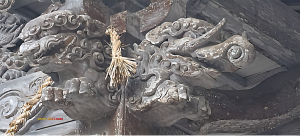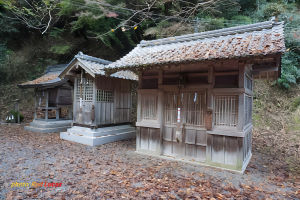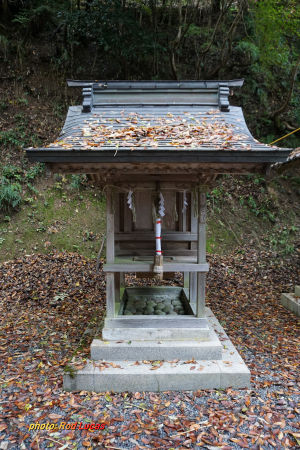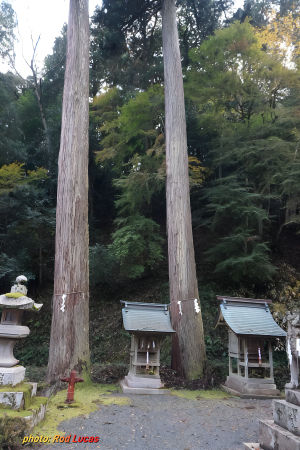普通の外にいくつかの著名な品質を持っている、と畏敬の念を起こさせるあるいかなるビーイングは、カミと呼ばれています。

homepage: none
大川神社
Kyoto-fu, Maizuru-shi Okawa 589
Okawa Jinja
京都府舞鶴市字大川589
November 23, 2025
Nearest station: Nishi Maizuru Line: JR, 17 mins by bus

Enshrined Kami:
Main
Uke-mochi-no-kami 保食神
Others
Kukunochi-Kami 句句廼馳神
Kagutsuchi-Kami 軻遇突智神
Haniyama-hime-Kami 埴山姫神
Kanayama-hiko-kami 金山毘古神
Mizuhame-Kami 罔象女神
In-ground Subordinate Shrines:
Yamiyoke Jinja 病除神社
Kusushinooya Jinja 医祖神社
Kamado Jinja 竈神社
Kowa Jinja 興和神社
Nonomiya Jinja 野々宮神社
Annual Festival: Last Sunday of October
I was shown around this shrine, and other shrines in Maizuru, by a good friend and resident of the city, Junko Nomura. The shrine legend tells us that its origins date to March 23, 485 during the reign of the 23rd emperor, Kenzo, when the shrine pillars were erected and the deity enshrined, although the details are not clear. A ceremony was held on September 28 of the following year and the shrine became known as Tenichi Okawa Daimyojin. In 859 it was given Junior Fifth ranking and in 861 it was raised to Senior Fifth Rank Lower ranking. It is included in the Tango Province, Kasa District entry in the Engi-Shiki, where of eleven shrines it is the only one designated as major. It is also one of the 285 shrines listed in the same work whose Kami is officially recognized as Myojin (名神).It is also mentioned in the Six National Histories.
During the Edo Period it received the patronage of the Hosokawa Clan, the lords of Tanabe Province. In 1872 it was designated a Village Shrine, and in 1919 it became a Prefectural Shrine. In 1881 it was named as Okawa Jinja in a letter from an imperial prince.
The current main hall was built in 1872, the prayer hall in 1820, and the central gate in 1790. All three buildings were named as Designated Cultural Properties by Maizuru City in 1996. There is a Sazare-ishi in the shrine grounds.
Note that the five non-Main Kami are also Kami of the five elements, Kukunochi of trees/wood, Kagutsuchi of fire, Haniyama-hime of earth, Kanayama-hiko of metal, and Mizuhame of water. Note also that they are all closely associated with Izanami’s death. It was while giving birth to Kagutsuchi that her vagina burned and she died a very painful death. The two Kanayama emerged from her vomit as she lay dying; the two Haniyasu and Mizuhane from her faeces.
Click images to expand






click images to expand


















